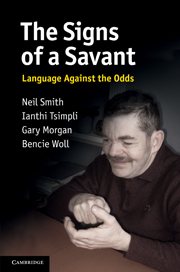4 - The results
Published online by Cambridge University Press: 05 July 2014
Summary
Introduction
We have reported elsewhere (Morgan et al., 2002a, 2002b) on Christopher’s proficient development, both in production and comprehension, of single signs, and we observed that, despite deficits in motor coordination, he acquired the basic parameters of sign formation sufficiently well to underpin a good working vocabulary. This supports our prediction that he would be able to overcome his difficulties in motor coordination and develop mastery of the lexicon. Nevertheless, he showed certain modality effects in that his comprehension of signs was always better than his production and his signing was appreciably slower than his (L2) speaking. Further, despite his vocabulary learning being within normal limits, some interesting differences between Christopher and the controls with regard to sign formation and iconicity were found.
In this chapter we provide an overview of the learning of BSL by Christopher and the members of the comparator group (4.2), we continue with a discussion of the results of our tests of iconicity and gesture (4.3), and then look in turn at his lexical development (4.4) and different aspects of his mastery of syntax (4.5–4.7), especially classifiers (4.6).
It is important to note that the data we present represent language used in a classroom situation. It is common in signing classes for students to repeat teacher-led language, as well as engage in topic-led conversation between learners or between the teacher and the students. The data from Christopher and the comparator group are not therefore truly spontaneous signing but they have approximately the same content and, most importantly, they are comparable between the subjects.
- Type
- Chapter
- Information
- The Signs of a SavantLanguage Against the Odds, pp. 84 - 139Publisher: Cambridge University PressPrint publication year: 2010

